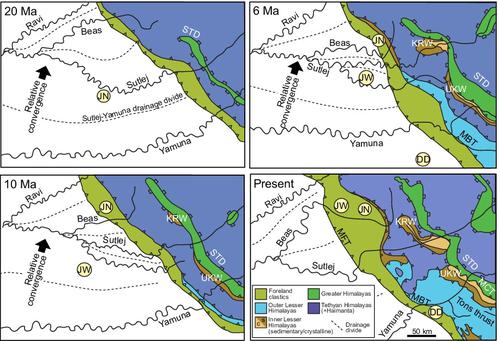当前位置:
X-MOL 学术
›
Basin Res.
›
论文详情
Our official English website, www.x-mol.net, welcomes your
feedback! (Note: you will need to create a separate account there.)
Late Miocene unroofing of the Inner Lesser Himalaya recorded in the NW Himalaya foreland basin
Basin Research ( IF 2.8 ) Pub Date : 2022-06-29 , DOI: 10.1111/bre.12689 Elise M. Exnicios 1 , Andrew Carter 2 , Yani Najman 3 , Peter D. Clift 1
Basin Research ( IF 2.8 ) Pub Date : 2022-06-29 , DOI: 10.1111/bre.12689 Elise M. Exnicios 1 , Andrew Carter 2 , Yani Najman 3 , Peter D. Clift 1
Affiliation

|
Testing models that link climate and solid Earth tectonics in mountain belts requires independent erosional, structural and climatic histories. Two well-preserved stratigraphic sections of the Himalayan foreland basin are exposed in NW India. The Jawalamukhi (13–5 Ma) and Joginder Nagar sections (21–13 Ma) are dated by magnetostratigraphy and span a period of significant climate change and tectonic evolution. We combine sediment geochemistry, detrital zircon U–Pb dating and apatite fission track analyses to reconstruct changes in the patterns of erosion and exhumation in this area from the Early Miocene to Pliocene. The provenance of the foreland sediments reflects a mixture of Tethyan and Greater Himalayan sources from 21 to 11 Ma, with influx from the Inner Lesser Himalaya starting after 11 Ma, and a strong increase in Crystalline Inner Lesser Himalayan erosion after 8 Ma. This distinct shift in provenance most likely reflects exhumation of the Kullu-Rampur Window, as well as the northward motion of the Jawalamukhi section towards the Himalayas, drainage reorganization in the foreland, and/or tectonically driven drainage capture in the mountains. Prior to 10.5 Ma sediment came from a large river whose sources were Greater Himalaya and Haimanta dominated, likely a palaeo-Sutlej, while after 8 Ma the source river was dominated by a more local drainage. Our work is consistent with Nd isotope and mica Ar-Ar constraints from the same sections that demonstrate initial Inner Lesser Himalayan unroofing in this region from 11 Ma, earlier than the 2 Ma implied from the marine record and during a period of summer monsoon weakening when fission track data indicate very rapid cooling and erosion of the Lesser Himalaya sources from no later than 10 Ma. Tectonically driven rock uplift coupled with southerly migration of the maximum rainfall belt during a time of drying, may have focused erosion over the Lesser Himalayan Duplex and created the Kullu-Rampur Window.
中文翻译:

记录在喜马拉雅西北前陆盆地的内小喜马拉雅晚中新世去顶
测试连接山带气候和固体地球构造的模型需要独立的侵蚀、结构和气候历史。喜马拉雅前陆盆地的两个保存完好的地层剖面暴露在印度西北部。Jawalamukhi(13-5 Ma)和 Joginder Nagar 剖面(21-13 Ma)是通过磁力地层学测定的,跨越了一段显着的气候变化和构造演化时期。我们结合沉积物地球化学、碎屑锆石 U-Pb 测年和磷灰石裂变径迹分析来重建该地区从早中新世到上新世的侵蚀和折返模式的变化。前陆沉积物的来源反映了 21 至 11 Ma 的特提斯和大喜马拉雅源的混合,11 Ma 后从内小喜马拉雅流入,8 Ma 后结晶内小喜马拉雅侵蚀强烈增加。出处的这种明显变化很可能反映了 Kullu-Rampur Window 的挖掘,以及 Jawalamukhi 部分向喜马拉雅山的北移,前陆的排水系统重组,和/或山区构造驱动的排水系统捕获。在 10.5 Ma 之前,沉积物来自一条大河,其源头主要是大喜马拉雅山和海曼塔河,可能是 palaeo-Sutlej,而在 8 Ma 之后,源河主要由更局部的排水系统控制。我们的工作与来自同一剖面的 Nd 同位素和云母 Ar-Ar 约束一致,这些剖面展示了该地区从 11 Ma 开始的内小喜马拉雅山开顶,早于海洋记录所暗示的 2 Ma,并且在夏季风减弱期间,裂变径迹数据表明小喜马拉雅源的快速冷却和侵蚀不迟于 10 Ma。构造驱动的岩石隆起加上干燥时期最大降雨带向南的迁移,可能集中侵蚀了小喜马拉雅双峰并形成了 Kullu-Rampur 窗口。
更新日期:2022-06-29
中文翻译:

记录在喜马拉雅西北前陆盆地的内小喜马拉雅晚中新世去顶
测试连接山带气候和固体地球构造的模型需要独立的侵蚀、结构和气候历史。喜马拉雅前陆盆地的两个保存完好的地层剖面暴露在印度西北部。Jawalamukhi(13-5 Ma)和 Joginder Nagar 剖面(21-13 Ma)是通过磁力地层学测定的,跨越了一段显着的气候变化和构造演化时期。我们结合沉积物地球化学、碎屑锆石 U-Pb 测年和磷灰石裂变径迹分析来重建该地区从早中新世到上新世的侵蚀和折返模式的变化。前陆沉积物的来源反映了 21 至 11 Ma 的特提斯和大喜马拉雅源的混合,11 Ma 后从内小喜马拉雅流入,8 Ma 后结晶内小喜马拉雅侵蚀强烈增加。出处的这种明显变化很可能反映了 Kullu-Rampur Window 的挖掘,以及 Jawalamukhi 部分向喜马拉雅山的北移,前陆的排水系统重组,和/或山区构造驱动的排水系统捕获。在 10.5 Ma 之前,沉积物来自一条大河,其源头主要是大喜马拉雅山和海曼塔河,可能是 palaeo-Sutlej,而在 8 Ma 之后,源河主要由更局部的排水系统控制。我们的工作与来自同一剖面的 Nd 同位素和云母 Ar-Ar 约束一致,这些剖面展示了该地区从 11 Ma 开始的内小喜马拉雅山开顶,早于海洋记录所暗示的 2 Ma,并且在夏季风减弱期间,裂变径迹数据表明小喜马拉雅源的快速冷却和侵蚀不迟于 10 Ma。构造驱动的岩石隆起加上干燥时期最大降雨带向南的迁移,可能集中侵蚀了小喜马拉雅双峰并形成了 Kullu-Rampur 窗口。











































 京公网安备 11010802027423号
京公网安备 11010802027423号